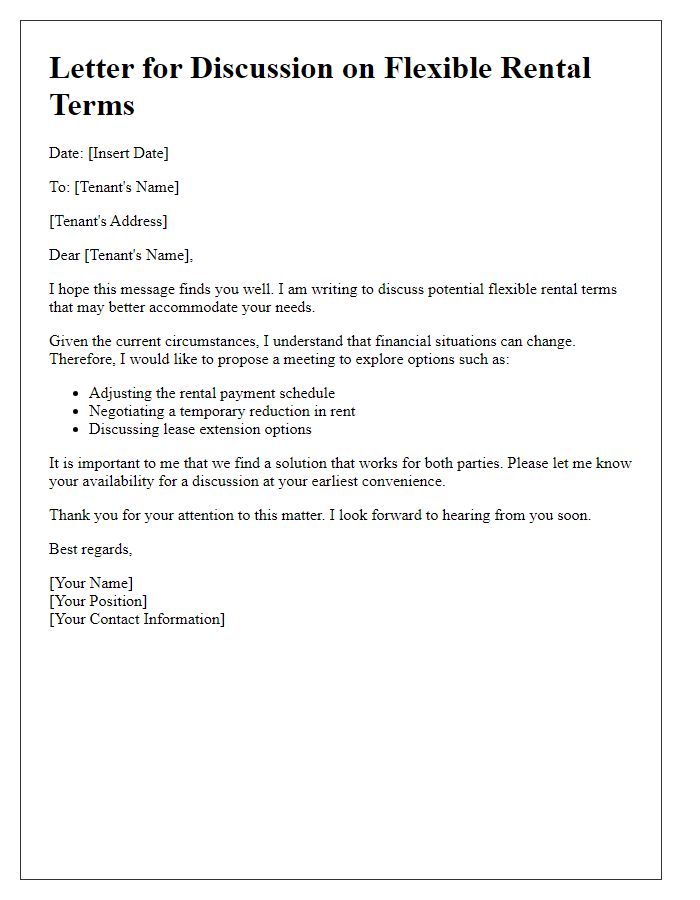Are you navigating the tricky waters of long-term rent negotiations? It can be daunting, but with the right approach, you can foster a positive relationship with your landlord while ensuring your needs are met. This letter template will help you articulate your thoughts clearly and effectively, paving the way for a successful discussion. So, let's dive in and explore the essential elements you should include to strengthen your position!

Current Market Analysis
Current rental market trends indicate a notable increase in rental prices across major metropolitan areas, specifically cities like New York and San Francisco. Average rent has surged by approximately 10% year-over-year, influenced by rising demand for housing in urban centers. Property vacancy rates in these urban locations have decreased to around 5%, creating a competitive environment for prospective tenants. Additionally, economic factors such as inflation and interest rates, currently sitting above 5%, are contributing to increased housing costs. Analyzing comparable rentals within similar neighborhoods reveals a consistent pattern of escalating prices, making it essential to consider these dynamics in any long-term rental agreements.
Comparable Property Rates
Long-term rental negotiations often focus on comparable property rates within a specific neighborhood or city. For instance, in San Francisco, average rent for a one-bedroom apartment reached $3,500 per month in 2023, while similar properties in nearby Oakland offered rates averaging $2,500. Comparing amenities can also highlight discrepancies; properties in desirable areas may include features like in-unit laundry, high-speed internet, and access to public transportation, significantly affecting rental prices. It is essential to consider local market trends, such as vacancy rates (currently at 5% in San Francisco), which can influence landlords' flexibility on pricing. Understanding square footage comparisons, neighborhood safety ratings, and proximity to key locations like schools and workplaces ensures a well-rounded approach to rental discussions. Incorporating these details enhances the negotiation strategy and establishes a solid basis for achieving favorable rental terms.
Tenant Track Record
A strong tenant track record can greatly enhance the prospects of successful long-term rent negotiations. Reliable tenants often demonstrate consistent monthly payments, showcasing financial responsibility and commitment to their living arrangements. A history of positive landlord references reflects respect for property maintenance and adherence to lease terms, which reassures landlords about future behavior. Additionally, an extended stay--averaging three years in the rental market--can indicate stability and predictability, both of which landlords desire. In cities like New York, where the rental market is competitive, a robust tenant track record can lead to favorable lease terms, lower security deposits, and decreased yearly rent increases due to established trust and proven reliability.
Proposed Terms and Conditions
Proposed terms for long-term rent negotiation often include key factors such as duration of lease, rental price per month, security deposit amount, maintenance responsibilities, and conditions for termination. Length of lease typically considered is 12 months or longer. Monthly rent prices may range from $1,500 to $3,000, depending on location such as urban areas versus suburban neighborhoods. Security deposits commonly equal one month's rent, while maintenance responsibilities can dictate whether landlords or tenants handle repairs. Important conditions for termination often encompass notice periods, typically 30 to 60 days, allowing both parties to plan adequately. Such negotiations contribute significantly to ensuring satisfaction in rental agreements for both landlords and tenants.
Potential Property Improvements or Repairs
Long-term rental negotiations can significantly benefit from proposing potential property improvements or repairs to enhance living conditions. In multifamily dwellings, renovations such as modernizing kitchen appliances, for example energy-efficient refrigerators or dishwashers, can improve convenience and reduce utility bills. Upgrading bathroom fixtures, particularly water-saving toilets and showerheads, not only promotes sustainability but also enhances tenant satisfaction. Addressing structural concerns, such as roof repairs or window replacements, ensures safety and energy efficiency, preventing future issues and costs. Outdoor improvements, like landscaping or paving driveways, can enhance curb appeal, contributing to overall property value. Timely painting and flooring upgrades can create a fresh atmosphere that attracts quality tenants in a competitive real estate market.
















Comments